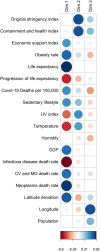Covid-19 Mortality: A Matter of Vulnerability Among Nations Facing Limited Margins of Adaptation
- PMID: 33330343
- PMCID: PMC7710830
- DOI: 10.3389/fpubh.2020.604339
Covid-19 Mortality: A Matter of Vulnerability Among Nations Facing Limited Margins of Adaptation
Abstract
Context: The human development territories have been severely constrained under the Covid-19 pandemic. A common dynamics has been observed, but its propagation has not been homogeneous over each continent. We aimed at characterizing the non-viral parameters that were most associated with death rate. Methods: We tested major indices from five domains (demography, public health, economy, politics, environment) and their potential associations with Covid-19 mortality during the first 8 months of 2020, through a Principal Component Analysis and a correlation matrix with a Pearson correlation test. Data of all countries, or states in federal countries, showing at least 10 fatality cases, were retrieved from official public sites. For countries that have not yet finished the first epidemic phase, a prospective model has been computed to provide options of death rates evolution. Results: Higher Covid death rates are observed in the [25/65°] latitude and in the [-35/-125°] longitude ranges. The national criteria most associated with death rate are life expectancy and its slowdown, public health context (metabolic and non-communicable diseases (NCD) burden vs. infectious diseases prevalence), economy (growth national product, financial support), and environment (temperature, ultra-violet index). Stringency of the measures settled to fight pandemia, including lockdown, did not appear to be linked with death rate. Conclusion: Countries that already experienced a stagnation or regression of life expectancy, with high income and NCD rates, had the highest price to pay. This burden was not alleviated by more stringent public decisions. Inherent factors have predetermined the Covid-19 mortality: understanding them may improve prevention strategies by increasing population resilience through better physical fitness and immunity.
Keywords: COVID-19; demography; environment; lockdown; niche adaptation; public health.
Copyright © 2020 De Larochelambert, Marc, Antero, Le Bourg and Toussaint.
Figures






Comment in
-
Commentary: COVID-19 Mortality: A Matter of Vulnerability Among Nations Facing Limited Margins of Adaptation.Front Public Health. 2021 Apr 16;9:642825. doi: 10.3389/fpubh.2021.642825. eCollection 2021. Front Public Health. 2021. PMID: 33937173 Free PMC article. No abstract available.
References
-
- Olshansky SJ, Carnes BA. The future of human longevity. In: Uhlenberg P. editor. International Handbook of Population Aging International Handbooks of Population (Springer Netherlands; ) (2009). p. 731–45. Available online at: http://link.springer.com/chapter/10.1007/978-1-4020-8356-3_33 (accessed August 8, 2013). - DOI
MeSH terms
LinkOut - more resources
Full Text Sources
Medical

